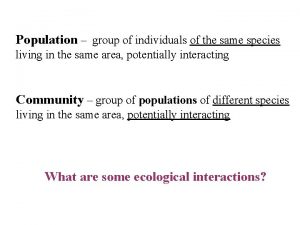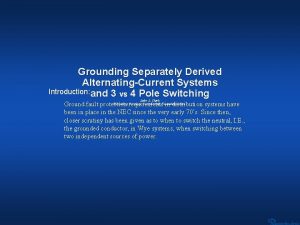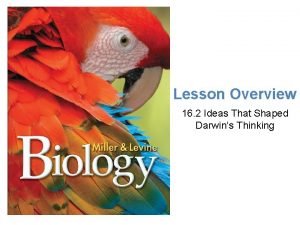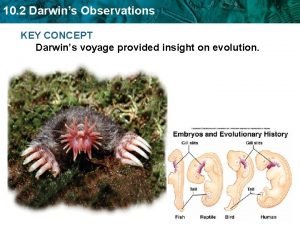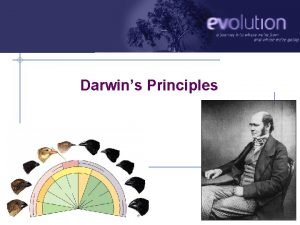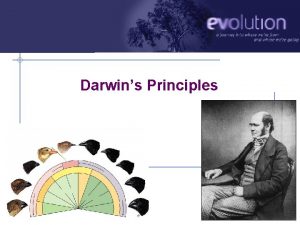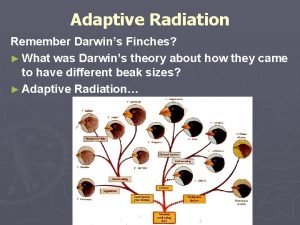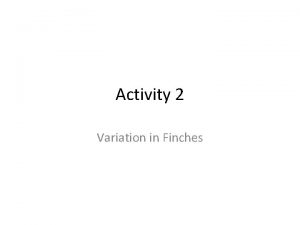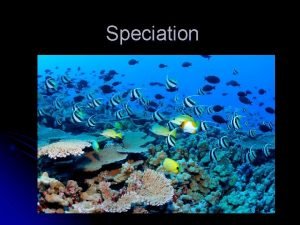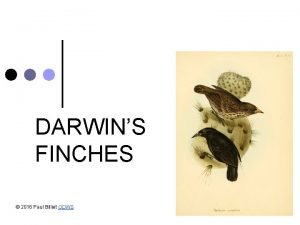Darwins finches When 2 species occur separately individuals










- Slides: 10

Darwin’s finches • When 2 species occur separately, individuals of both species have beaks of the same size. • When species co-occur, members of one species has larger beaks and eat larger seeds than the other species http: //www. terraquest. com/galapagos/wildlife/island/finch. html

David Lack measured bill depth in Darwin’s finches mm For 2 finch species: Geospiza fulignosa G. fortis Allopatry Sympatry 8. 5 - 10. 5 8. 5 - 11. 5 7 - 9. 5 11 - 16 This is called Character Displacement

“Character Displacement: divergence in the characteristics of 2 otherwise similar species where their ranges overlap, caused by the selective effects of competition between species in the area of overlap. ” Ricklefs (2001)

Beak depths do not overlap where > 1 sp occurs together On islands with only 1 species, beaks are an intermediate depth Ricklefs 2001 Fig. 20. 13

Character displacement: 1. Is an evolutionary process that - involves genetic changes - is not observable in ecological time 2. Appears to be rare. 3. Is not possible to test experimentally. 4. Provides indirect evidence for competition in the past.

Is there some other explanation for character displacement? Some suggest that species that share a resource might show CHARACTER CONVERGENCE 1. Start with a resource: seed size 2. One species uses this resource on an island 3. Second species invades (with a beak size quite different than resident): - initially competition may be very weak - later, increase in competition until coexistence.

Resource Distribution Abundance Seed Size Frequency Species #1 Beak Size Species 2 newly arrived

Species 2 Frequency Species 1 Beak Size Later in time: - coexistence between two species (character convergence) - gives the same appearance as character displacement

What can we conclude about theory of competition? 1. Strict Laws: - too simple & unrealistic - assumptions are often wrong 1. No age structure (individuals are equivalent) 2. Ks are constant 3. Competition coefficients are density independent 4. No time lags: species effects are instantaneous Despite drawbacks, theory helps ecologists to direct experiments

What can we conclude about theory of competition? 2. How did the competition paradigm become so prevalent? Kuhn. , T (1962) The Structure of Scientific Revolutions. 2 nd edition Univ. of Chicago Press 210 p. -Paradigms might be in error, but carry on for a long time until there is some “scientific revolution” Thomas Kuhn
 What is a group of individuals of the same species
What is a group of individuals of the same species Plant keystone species
Plant keystone species Dc motor efficiency formula
Dc motor efficiency formula Separately disclosable items
Separately disclosable items Separately derived system
Separately derived system Shunt
Shunt Non separately derived system grounding diagram
Non separately derived system grounding diagram What is cyclic menu
What is cyclic menu Chapter 17 darwins theory of evolution
Chapter 17 darwins theory of evolution Lesson 2 ideas that shaped darwins thinking
Lesson 2 ideas that shaped darwins thinking Darwins observations
Darwins observations
